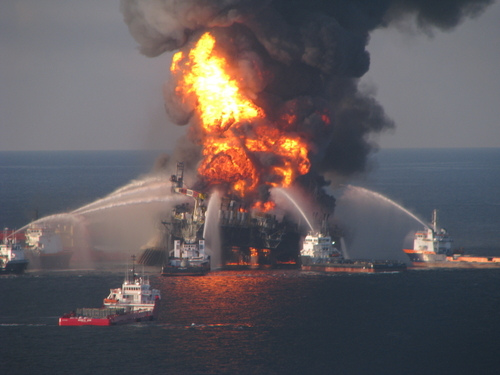
Photo by uscgd8, <a href="http://www.flickr.com/photos/uscgd8/4542937668/in/photostream/">via Flickr</a>.
There were a number of warning signs in the 24 hours before the blast that destroyed the Deepwater Horizon on April 20. Failed tests, concerns with equipment, and building pressure in the well indicated problems with the operation, according to a report released by a congressional committee investigating the disaster.
“[K]ey questions exist about whether proper procedures were followed for critical activities throughout the day” of the blast, the report concludes. While of their memo reaffirms information that has come out in hearings, it also raises new questions about some of the warning signs before the blast.
The report was compiled by the House Energy and Commerce Committee from internal documents from BP (the rig’s operator), Transocean (the rig’s owner), and Halliburton (the company that poured the cement for the well). It notes that there were signs that too much gas was entering the well and that the cement job on the well might have been faulty. But it appears that those problems may have been ignored and proper procedures were not followed.
From the committee’s summary:
According to BP there were three flow indicators from the well before the explosion. One was 51 minutes before the explosion when more fluid began flowing out of the well than was being pumped in. Another flow indicator was 41 minutes before the explosion when the pump was shut down for a “sheen” test, yet the well continued to flow instead of stopping and drill pipe pressure also unexpectedly increased. Then, 18 minutes before the explosion, abnormal pressures and mud returns were observed and the pump was abruptly shut down. The data suggests that the crew may have attempted mechanical interventions at that point to control the pressure, but soon after, the flow out and pressure increased dramatically and the explosion took place. Further, BP’s preliminary findings indicate that there were other events in the 24 hours before the explosion that require further inquiry.
The report isn’t conclusive; the information is drawn from company documents, and so far each company involved has pointed the finger at the others for failures on the rig that might have lead to the blast. Hearings on the explosion and spill continue today in Louisiana focusing on what happened on the rig that day. In Washington, the House Natural Resources Committee will hold hearings Wednesday with government regulators overseeing drilling, and on Thursday with the CEOs of companies involved in the accident.
(If you appreciate our BP spill coverage, please consider making a tax-deductible donation in support.)













